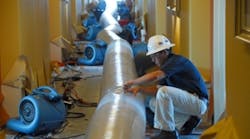When thousands of gallons of water flooded a new 1,400-room Hilton Orlando under construction and set to open in less than one month, it was like a scene from a nearby water park in the popular Florida resort area. But fast action and expert drying by Munters Moisture Control Services (MCS) assured that the construction schedule proceeded as planned.
Water gushed through hallways, guest rooms, stairwells, and elevator shafts, and cascaded 19 floors down to the hotel lobby.
Only the top three floors remained to be completed, when an elbow joint in the main hot water feed on the roof of the 19th floor came apart. Water gushed through hallways, guest rooms, stairwells, and elevator shafts, and cascaded 19 floors down to the hotel lobby.
“Water flooded through a pipe shaft into a single guest room on the top floor, and then into elevator shafts and a nearby stairwell before spreading to various floors of the building,” says Brian Kuckelman, senior vice president of architecture and construction for Rida Development, the developer handling the Hilton Orlando project.“Every floor experienced water damage, and the amount of water was so extensive that it blew out the lobby ceiling, 19 stories below the pipe break.”
The flooding raised concerns about the hotel’s scheduled completion – less than a month away. A representative from the project’s general contractor, Welbro Building Constructors, who was familiar with Munters MCS’ capabilities, immediately contacted Ken Gennett, Florida restoration account manager for Munters MCS, who was on site within 45 minutes to assess the damage. Other local restoration companies also were contacted to submit proposals to conduct the massive drying portion.
“When I arrived on site, water was still pouring everywhere,” says Gennett. “It drenched you from above, ran through the lobby and flowed down the stairs.”
Within hours, Gennett had equipment up and running, including portable desiccant dehumidifiers, air movers and dehumidifiers in rooms and hallways. MCS personnel were on site by the middle of the night, and by early morning, additional equipment had arrived from all over the country.
“Thanks to the company’s rapid response, sound advice, breadth of capabilities, and a recommendation from the general contractor, we decided Munters was the ideal candidate for the job,” says Kuckelman.
How They Did It
The huge project required quickly drying out all structural components, including carpeting and walls and ceilings in rooms and hallways, and maintaining good air quality to preclude any formation of mold. Munters utilized 18 desiccant dehumidification units of varying sizes plus 130 smaller refrigerant units placed strategically throughout saturated areas of the hotel. The larger dehumidification units provided dry air to varying floors of the hotel through ductwork situated up the side of the building.
Munters also used 1,500 air movers arranged in hallways and rooms during the course of the project. A 53-foot enclosed catastrophe supply trailer was on site as well as three first emergency response units each containing a dehumidifier, a fuel cell and a generator housed in the trailer. The project brought many challenges. Because the hotel didn't have adequate power to handle the load of all the drying equipment, nine diesel generators were used to temporarily power the equipment.
“The hotel transformers were not designed for every room to be on full load simultaneously so we brought in distribution power to most of the floors that required tons of cable distribution,” says Gennett. With the hotel elevators out of service for several days, personnel carried dehumidifiers and air movers, some weighing as much as 200 pounds, up stairwells to all of the floors in the warm, humid conditions typical of Florida weather.
Mission Accomplished
The operation accomplished the task of minimizing tearout and preventing mold growth, saving tons of drywall, paint, carpet and other building materials, and the time it would take to replace all of them.
“Significant areas of carpet and pad that were going to be discarded by the building contractor were able to be saved due to our quick response,” says Gennett. “Also, minimal drywall was torn out from the 18th floor down. Some of the lobby ceiling was removed due to the damage there, but overall we saved many materials.”
The drying process throughout the hotel was completed in just over a week, after which the furnishing of the rooms and construction commenced.
“This was a total team effort, with everyone responding immediately to keep the damages to interior finishes to a minimum,” Gennett says. “Fortunately, with today’s engineered systems that factor in years of water recovery experience, there is a solution for every situation we encounter.”
“The quick response plus the availability of large numbers of personnel and equipment all contributed to a shorter time for the effects of water damage to the structure and building materials,” adds Kuckelman. The success of the project was illustrated by the fact that the hotel opened last fall as planned.
“It was a Herculean task to achieve an on-time opening, not just by Munters but by the construction firm, county officials who had to re-certify the building for occupancy, and all of our many vendors who had to replace building materials, furniture and amenities,” Kuckelman says.








